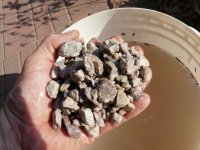The rock is left over from my driveway paver project. I used it as the base and compacted it and then put sand on top of it, leveled/sloped it then tapped in/set the pavers and then used polymer sand to bind it all together. Well, the first 500, I still have 12,000 to lay after I finish the last 160' of curbing.
Kyle the water is flowing from all sides, I can't really pinpoint a specific spot. Is this how a spring flows?
It seems like the clay has fingers of sand running through it in it and the water is following through the sand fingers, straw size.
Don,
This will really sound like a dumb question/questions on my part, at this point of your project, but your latest pictures want me to ask if the top of your 5' ring that is now temporarily set is your intended full water level of the pond and if so, is that the spill over point of the pond at some point on the bank?
I keep wanting to reference the white plastic pipe with the blue cap shown in your pictures before digging to the hole you are preparing to dig but the pipe
hasn't been in any of your recent photos since the trac hoe was there.
I thought the place you are putting the culvert was basically below where the pipe used to be?
I realize the pit you are digging for the culvert stems from Jim saying something like.... too bad he didn't dig a 9 foot deep hole for a spring box.
It sounds like your answer and question about the water oozing out of the clay in straw sized sand holes ( to Kyle ), means the water is oozing out of the 6 foot sidewalls above and around the top of your 5' culvert piece.
If so, what are your plans to keep the sidewalls from eroding or plugging and
is the real purpose of the culvert then to act only as a mud/sludge catch basin for the seep that you intend to pump out from time to time? You must be going to dam off the culvert area from the pond so the seep can't go directly to the pond and have a pipe leaving the side of the culvert where the water has become clear of mud and sand to fill the pond?
But then you talked about letting the cows have access to the pond, which in a short time will make the bottom a muck hole again where they stand.
I guess I better just shut-up and be one of those lurkers that see what happens, rather than trying to help.
Ron

